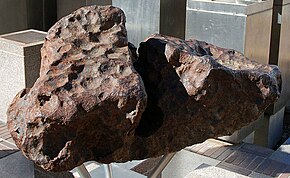
A meteorite is a solid piece of debris from an object, such as a comet, asteroid, or meteoroid, that originates in outer space and survives its passage through the atmosphere to reach the surface of a planet or moon. When the original object enters the atmosphere, various factors such as friction, pressure, and chemical interactions with the atmospheric gases cause it to heat up and radiate energy. It then becomes a meteor and forms a fireball, also known as a shooting star; astronomers call the brightest examples "bolides". Once it settles on the larger body's surface, the meteor becomes a meteorite. Meteorites vary greatly in size. For geologists, a bolide is a meteorite large enough to create an impact crater.

Campo del Cielo refers to a group of iron meteorites and the area in Argentina where they were found. The site straddles the provinces of Chaco and Santiago del Estero, located 1,000 kilometers (620 mi) north-northwest of Buenos Aires, Argentina and approximately 500 kilometres (310 mi) southwest of Asunción, Paraguay. The crater field covers 18.5 by 3 kilometres and contains at least 26 craters, the largest being 115 by 91 metres.

An iron meteorite fell on the Sikhote-Alin Mountains, in southeastern Russia, in 1947. Large iron meteorite falls have been witnessed and fragments recovered but never before, in recorded history, a fall of this magnitude. An estimated 23 tonnes of fragments survived the fiery passage through the atmosphere and reached the Earth.

The Cape York meteorite, also known as the Innaanganeq meteorite, is one of the largest known iron meteorites, classified as a medium octahedrite in chemical group IIIAB. In addition to many small fragments, at least eight large fragments with a total mass of 58 tonnes have been recovered, the largest weighing 31 tonnes. The meteorite is named after the location where the largest fragment was found: 23 miles (37 km) east of Cape York, in Savissivik, Meteorite Island, Greenland.
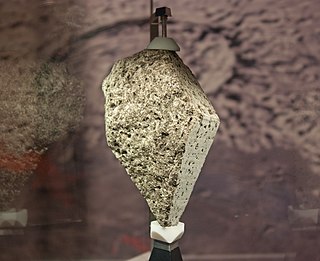
Moon rock or lunar rock is rock originating from Earth's Moon. This includes lunar material collected during the course of human exploration of the Moon, and rock that has been ejected naturally from the Moon's surface and landed on Earth as meteorites.

Iron meteorites, also called siderites or ferrous meteorites, are a type of meteorite that consist overwhelmingly of an iron–nickel alloy known as meteoric iron that usually consists of two mineral phases: kamacite and taenite. Most iron meteorites originate from cores of planetesimals, with the exception of the IIE iron meteorite group

The Hoba meteorite is named after the farm Hoba West, where it lies, not far from Grootfontein, in the Otjozondjupa Region of Namibia. It has been uncovered, but because of its large mass, has never been moved from where it fell. The main mass is estimated at more than 60 tonnes. It is the largest known intact meteorite and about twice as massive as the largest fragment of either the Cape York meteorite's 31-tonne Ahnighito kept in the American Museum of Natural History or the Campo del Cielo's 31-tonne Gancedo in Argentina. It is also the most massive naturally occurring piece of iron known on Earth's surface. The name "Hoba" comes from a Khoekhoegowab word meaning "gift". Following its donation to the government in 1987, a visitor centre was constructed with a circular stone access and seating area.
Gibeon is a village in Gibeon Constituency in the Hardap Region of Namibia.
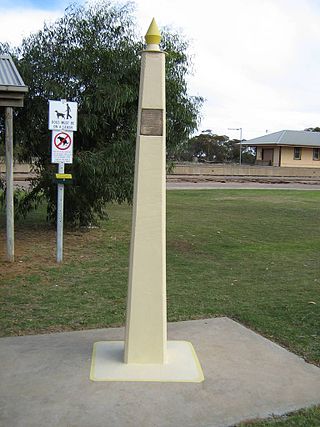
The Karoonda meteorite is a meteorite that fell to earth on 25 November 1930 at 10:53 pm near the South Australian town of Karoonda. It is of a rare composition, being carbonaceous chondrite, and is also rare in that it was found so soon after its landing. Several fragments are now held in the South Australian Museum in Adelaide.
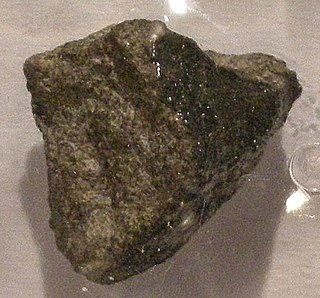
Stannern meteorite fell on May 22, 1808 into the Moravian village Stonařov, in today's Czech Republic.
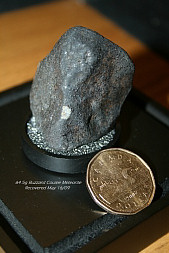
Buzzard Coulee is the collective name of the meteorites fallen on November 20, 2008 over Saskatchewan, Canada.

Otjikoto Lake is the smaller of only two permanent natural lakes in Namibia. It is a sinkhole lake that was created by a collapsing karst cave. It is located 20 kilometres (12 mi) north-west of Tsumeb and only 100 meters from the main road B1. The lake was declared a national monument in 1972.
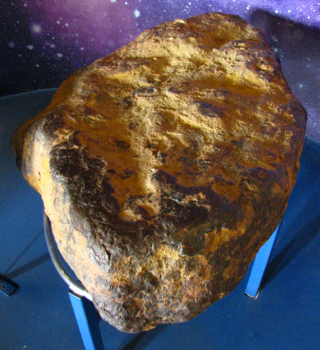
The Muonionalusta meteorite is a meteorite classified as fine octahedrite, type IVA (Of) which impacted in northern Scandinavia, west of the border between Sweden and Finland, about one million years BCE.
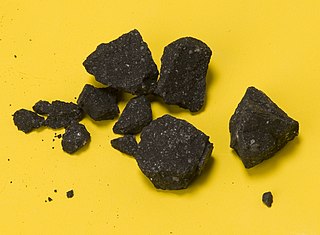
The Sutter's Mill meteorite is a carbonaceous chondrite which entered the Earth's atmosphere and broke up at about 07:51 Pacific Time on April 22, 2012, with fragments landing in the United States. The name comes from Sutter's Mill, a California Gold Rush site, near which some pieces were recovered. Meteor astronomer Peter Jenniskens assigned Sutter's Mill (SM) numbers to each meteorite, with the documented find location preserving information about where a given meteorite was located in the impacting meteoroid. As of May 2014, 79 fragments had been publicly documented with a find location. The largest (SM53) weighs 205 grams (7.2 oz), and the second largest (SM50) weighs 42 grams (1.5 oz).

The Nantan meteorite is an iron meteorite that belongs to the IAB group and the MG subgroup.

The Mundrabilla meteorite is an iron meteorite found in 1911 in Australia, one of the largest meteorites found, with a total known weight of 22 tonnes and the main mass accounting for 12.4 tonnes.

Fifteen pieces of the Kainsaz meteorite were seen to fall near Kainsaz, Muslyumovo, Tatarstan on September 13, 1937. The largest weighed 102.5 kilograms (226 lb), the total weight was ~200 kilograms (440 lb). As of January 2013 pieces were on sale for ~US$100/g. Kainsaz is the only observed fall in Tatarstan.

The geology of Namibia encompasses rocks of Paleoproterozoic, Mesoproterozoic and Neoproterozoic and Paleozoic to Cenozoic age. About 46% of the countryʼs surface are bedrock exposure, while the remainder is covered by the young overburden sediments of the Kalahari and Namib deserts.
Padvarninkai meteorite is a meteorite that fell on 9 February 1929 near the village of Padvarninkai located near Andrioniškis, Anykščiai District Municipality, Lithuania. It is a rare eucrite that contains maskelynite and is highly shocked.

The Winchcombe meteorite is a carbonaceous chondrite meteorite that was observed entering the Earth's atmosphere as a fluorescent green fireball over Gloucestershire, England, at 21:54 hours on 28 February 2021. Due to a public appeal, fragments were quickly recovered from the village of Winchcombe, enabling it to be collected for analysis before becoming degraded.
